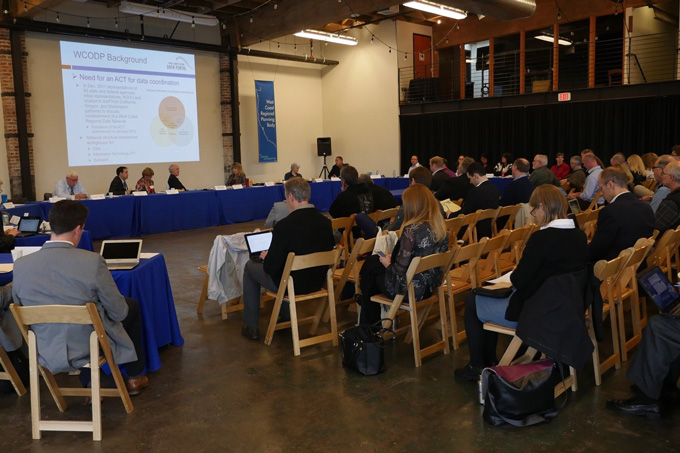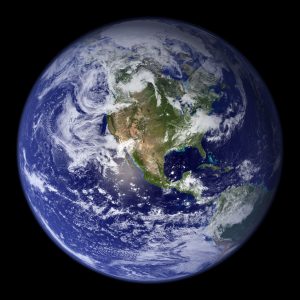11: The Future of Ocean Management
- Page ID
- 32326
How does a technologically advanced nation such as the United States achieve progressive stewardship and governance of its coasts and three million square miles of waters, seabed, and natural resources—not for the present alone but for the future? As the previous ten units’ explorations indicate, the US’ marine policies, laws and basis of scientific knowledge are continually expanding to become more sophisticated, responsive, and nuanced.
In managing our vast ocean wealth as with the country’s terrestrial resources, we seek to make decisions that are sustainable economically, socially, and ecologically (triple-bottom line sustainability) rather than short-sighted and selfish. The stark challenge before our and future generations is for our initial progress to keep pace with growing population and consumer demand, the increased uses of ocean space, and the complex problems we face on a planetary scale as we go about seeking to balance resource exploitation and profit with equitable provision of food, shelter, safety, cultural enrichment, energy, and opportunities for all people to learn and grow to our human potential (see the United Nations Universal Declaration on Human Rights, Unit 11 Resources).
The Trajectory of US Ocean Governance
The timeline encompassing the landmarks of the historic Stratton Commission Report, (Our Nation and the Sea (1964)) through the ambitious and comprehensive ocean commission reports in the early 2000s (PEW, America’s Living Oceans: Charting a Course for Sea Change, June 2003; US Ocean Commission, An Ocean Blueprint for the 21st Century, September 2004) is a single generation. Over the past half century we have taken stock of our enormous ocean wealth, our knowledge, and the achievements and gaps in public policy and the mosaic that is marine law. We have broadened our focus from urgent post-World War II concerns of fishing and food security, industrial development, foreign competition, and military strength to more comprehensively understand broader aspects of marine systems themselves, and the many thousands of benefits they provide, economic and otherwise. We are an ocean nation, as stated frequently, including in the PEW report’s executive summary. The growing awareness of this is, in itself, a powerful movement; we are also an ocean planet and part of an international commons.
Creative solutions in every field including ocean law and policy begin with awareness, connection, and imagination. One of the most important groundbreaking connections is viewing humans as part of the ecosystem, not apart. Law evolution, including in the Magnuson-Stevens Fisheries Act and others presented previously reflect this increased understanding. Another important connection, growing but as yet under-developed, is the realization that wherever we live our everyday choices influence the environment (that both immediately surrounds us, but also far away) including the coastal zone and the oceans. The chapters of this book are replete with examples, from sustainable seafood and other consumer choices, lawn and farm fertilizer practices, transportation and shipping and emissions, single-use plastics and beyond.
It is from the specific place each of us daily finds ourselves that awareness, connection, and imagination emerge to inform our forward movement as individuals, communities and a nation of ocean citizens, regardless of our backgrounds or professions. While problems are complex, immense and pressing, inspiration is available.

westcoastmarineplanning.org)
On the Horizon
The deeply informative major ocean policy initiatives of the early 2000s led to important and related ongoing projects (among many innovative goals): coordination and connectivity of coastal management to the larger ocean ecosystem. This led us to embrace ecosystem-based management nationally through ocean mapping and marine spatial planning nestled in five US coastal regions: the Northeast and the Mid-Atlantic (which have been developed, see this December 2016 news release and the links to the new regional planning units, nrdc.org/experts/alison-chase/national-ocean-policy-seven) as well as the evolving West Coast, the Caribbean and the Pacific Islands Planning Bodies (see links in resources for Unit Eleven). These bodies are not regulatory. The voluntary planning bodies support transparency and collaboration through sharing of knowledge, communication and coordination of policy needs and initiatives that are intended to support better decision making and decreased duplication and conflict between policies. The transparency and coordination are necessary to addressing the US ocean policy gaps and weaknesses that the two commissions identified.
In effect, the new planning bodies represent a distillation of the two ocean commisions’ multi-year investigations, evaluations, and findings. It is the regions that will advance the final the goals via their respective data portals and an integrated communication and decision-making framework for the members. Participants in the new regional planning bodies include coastal states, Tribes, federal agencies, the eight regional fisheries management councils, and marine stakeholders (including fishing, recreation, energy, transportation and shipping, telecommunications, and many others). While just beginning, the regional bodies’ efforts, to date, have already had success and represent a culmination of fifty years of policy development and finesse, much of which would not have been possible without advances in stakeholder engagement (ocean resource are our resources), leadership capacity development, ecosystem-based management and concomitant advances in science and technology including ocean observing.

Achieving greater awareness of the consequences of shore-side decisions on the coastal ocean and beyond is a longer-term ambition. An important development used increasingly outside the United States is integrated coastal zone management (ICZM), a logical development in view of the fact that sixty percent of Earth’s population and 21 of 33 coastal mega cities are within the coastal zone (Zacharias 2014). ICZM is also a logical and holistic extension of ecosystem-based management that moves beyond strictly sector-based management to take account of the whole in a systems view of energy inputs, outputs and flows. Tools will evolve to incorporate urban systems, and more importantly their planning for growth, to support science-informed sustainability. (For example, see the Nature Conservancy, Our Oceans Our Future urban planning tool in Unit 11 Resources).
While solid achievements in marine law and policy remain to be accomplished at national and international levels, the hard work and confrontation of uncertainty and risk necessary to take a leadership role in marine management are worth it. The future of this endeavor has never had higher stakes, nor offered greater rewards in terms new discoveries and achievement in innovations in technology, outreach, and engagement between environmental professionals at all levels and ocean citizens from all walks of life.
Inspired by a photo snapped by Voyager 1 (1990) in which the Earth appeared as an infinitely tiny speck of light, astronomer Carl Sagan (1934-1996) saw our watery planet this way; in turn we are inspired:
That’s here. That’s home. That’s us. On it everyone you love, everyone you know, everyone you ever heard of, every human being who ever was, lived out their lives. The aggregate of our joy and suffering, thousands of confident religions, ideologies, and economic doctrines, every hunter and forager, every hero and coward, every creator and destroyer of civilization, every king and peasant, every young couple in love, every mother and father, hopeful child, inventor and explorer, every teacher of morals, every corrupt politician, every “superstar,” every “supreme leader,” every saint and sinner in the history of our species lived there – on a mote of dust suspended in a sunbeam.
Sagan, A Pale Blue Dot: A Vision of the Human in Space (1994)

Unit Eleven Appendix


